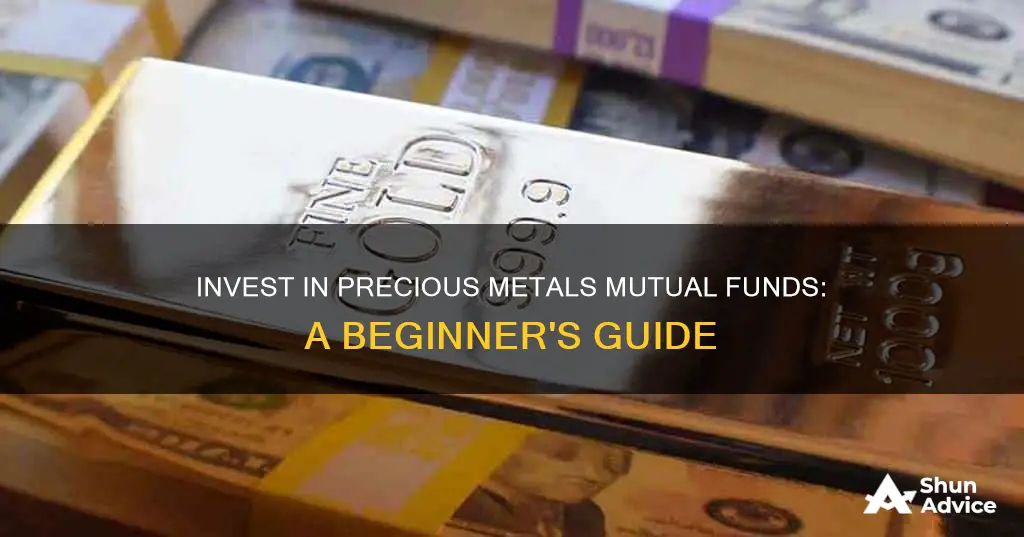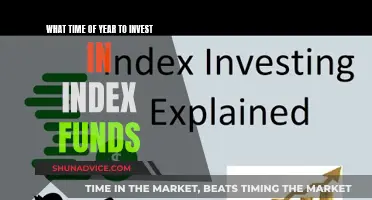
Precious metals mutual funds are a great way to diversify your portfolio and hedge against inflation. These funds primarily consist of mining stocks, with companies involved in the mining of metals such as gold, silver, and platinum. Some funds also purchase physical metals like gold and silver bullion. The major firms operating in this sector are typically headquartered in the United States, Canada, Australia, and South Africa, where many precious metal deposits can be found. When considering investing in precious metals mutual funds, it's important to assess your financial goals and risk tolerance. Gold, the most popular precious metal for investment, serves as a strong hedge against inflation and is in high demand for jewelry and currency.
| Characteristics | Values |
|---|---|
| Investment type | Precious metals mutual funds |
| Investment focus | Mining stocks, gold bullion, silver bullion |
| Geographic focus | North America, Australia, South Africa |
| Risk level | High volatility |
| Returns | Average of 27.69% over 1 year, 15.79% over 3 years, 13.46% over 5 years |
| Example funds | Allspring Precious Metals, Fidelity Select Gold Portfolio, Victory Capital Precious Metals and Minerals, Invesco Gold and Special Minerals |
What You'll Learn

Gold and silver bullion
There are several ways to invest in gold and silver bullion. Firstly, investors can purchase the physical bullion in the form of bars or coins from a reputable dealer. These can be kept in a safe deposit box at home, in a bank, or with a third-party depository.
Another option is to invest in exchange-traded funds (ETFs) that track the price of gold or silver. ETFs are a more liquid and low-cost way to invest in bullion, as they can be bought and sold like equities through a standard brokerage or IRA account. However, it is important to note that ETFs may not always track the exact price of physical gold or silver.
Investors can also buy bullion futures contracts, which are agreements to buy or sell bullion at a preset price on a specific date. This option allows investors to speculate on the price of gold or silver without taking physical delivery of the metal.
When investing in gold and silver bullion, it is important to consider factors such as storage, insurance, and liquidity. Bullion bars, for example, may be challenging to liquidate in larger sizes, and there is also a risk of theft.
Overall, gold and silver bullion can be a good investment option for those seeking to diversify their portfolio and hedge against inflation.
Cannabis Investment: Mutual Funds and the Green Rush
You may want to see also

Gold and silver ETFs
Some of the leading gold ETFs include:
- IShares Gold Trust Micro ETF (IAUM): This ETF tracks the London Bullion Market Association (LBMA) Gold Price and has gold bars held in vaults. It had an expense ratio of 0.15% as of August 18, 2022.
- SPDR Gold MiniShares Trust (GLDM): GLDM aims to reflect the performance of gold prices minus fund expenses. It is structured as a grantor trust and had a lower expense ratio of 0.10% compared to other precious metal ETFs as of August 18, 2022.
- SPDR Gold Shares (GLD): This is the largest gold ETF, with gold bullion stored in bank vaults. It offers high liquidity and an expense ratio of 0.4%.
Leading silver ETFs include:
- IShares Silver Trust (SLV): The largest silver ETF, enabling investors to participate in silver price upside with lower risks and hassles compared to alternative investments. It has a reasonable expense ratio of 0.5%.
- Aberdeen Standard Physical Silver Shares ETF (SLVR): This ETF provides investors with direct exposure to silver by holding physical silver bars in bank vaults.
It is important to note that owning shares of gold or silver ETFs does not equate to owning the physical metal. Investors should carefully consider the potential pros and cons, such as fees, counterparty risks, and the difficulty of exchanging shares for physical bullion during economic or geopolitical crises.
High-Yield Bond Funds: When to Invest and Why
You may want to see also

Mining stocks
Majors are typically large, well-capitalized companies with a long history, global operations, and a steady cash flow. They are usually less volatile and more mature, with a diverse portfolio of claims and substantial capital to fund further exploration. Examples of major mining companies include Barrick Gold, BHP Group, and Rio Tinto, all known for their low-cost operations and stable dividends.
On the other hand, juniors are smaller, younger companies with less capital and shorter histories. They are often involved in commodity exploration and carry more risk, but they offer the potential for high returns. Juniors may fail, be acquired by majors, or, in rare cases, strike a large and lucrative deposit.
When investing in mining stocks, it's important to consider the unique risks associated with the industry, such as commodity price fluctuations and geopolitical factors. Additionally, mining companies may differ in their ability to withstand economic downturns, with those having low production costs being more profitable and less reliant on debt.
To invest in mining stocks, individuals can purchase shares of mining companies directly or consider exchange-traded funds (ETFs) or mutual funds focused on the mining industry. It's recommended to carefully research and evaluate each investment option, considering factors such as the company's financials, feasibility studies, and market demand for the minerals they produce.
Target Date Funds: A Guide to Investing for Retirement
You may want to see also

Precious metals companies
Precious metals portfolios primarily consist of mining stocks, with companies involved in the mining of metals such as gold, silver, and platinum. Some funds also purchase small amounts of physical metals like gold or silver bullion.
- Allspring Global Investments: The Allspring Precious Metals Fund (EKWAX) focuses on long-term capital growth by investing in companies involved in the exploration, mining, and processing of gold and other precious metals.
- Fidelity Investments: The Fidelity Select Gold Portfolio Fund (FSAGX) focuses on providing investors with capital appreciation by investing in gold-related operations and gold bullion.
- Gabelli Funds: The Gabelli Gold Fund (GLDAX) aims for long-term capital appreciation by investing in companies engaged in gold-related operations and gold bullion.
- Victory Capital: The Victory Capital Precious Metals and Minerals Fund (USAGX) seeks to preserve the purchasing power of capital against inflation and reduce portfolio volatility by investing in companies involved in the exploration, mining, and processing of gold, silver, platinum, and other precious minerals.
- Invesco: The Invesco Gold and Special Minerals Fund (OPGSX) seeks long-term capital appreciation by investing in the stocks of mining companies focused on gold and other precious metals.
- US Global Investors: The Gold and Precious Metals Fund (USERX) is the first no-load gold fund in the US. It focuses on capital appreciation, inflation protection, and current income by investing in companies involved in mining, fabrication, processing, marketing, or distribution of metals, including gold, silver, and platinum.
- US Global Investors: The World Precious Minerals Fund (UNWPX) complements the Gold and Precious Metals Fund by offering increased exposure to junior and intermediate mining companies for added growth potential.
- First Eagle Investment Management: The First Eagle Gold Fund seeks to provide investors with the opportunity to participate in the investment characteristics of gold.
- Franklin Templeton Investments: The Franklin Gold and Precious Metals Fund focuses on capital appreciation and providing shareholders with current income.
- VanEck: The VanEck International Investors Gold Fund seeks long-term capital appreciation and current income by investing in gold-related companies.
Vanguard's Anti-Gun Investment: Funds for a Safer Future
You may want to see also

Mutual funds vs. ETFs
Mutual funds and exchange-traded funds (ETFs) are both popular ways to invest in precious metals and offer some similar benefits. However, there are some key differences between the two that investors should be aware of when deciding which option is best for them.
Similarities
Mutual funds and ETFs are similar in that they both provide investors with exposure to a wide range of asset classes and niche markets, including precious metals. Both types of investment also offer built-in diversification, as they typically include tens, hundreds, or even thousands of individual stocks or bonds in a single fund. This reduces the risk of investing in individual stocks or bonds, as poor performance in one area can be offset by gains in another. Additionally, both mutual funds and ETFs are overseen by professional portfolio managers who choose and monitor the investments in the fund.
Differences
One of the main differences between mutual funds and ETFs is how they are traded. Mutual funds can only be purchased at the end of each trading day, based on a calculated price known as the net asset value (NAV). In contrast, ETFs can be traded intra-day, just like stocks, and their prices fluctuate throughout the day. This means that investors have more control over the price they pay or receive when buying or selling ETFs. ETFs also typically have lower investment minimums than mutual funds, often requiring only the purchase of a single share. Mutual funds, on the other hand, usually have flat-rate minimum investments of several hundred or even thousands of dollars.
Another difference is in how the funds are managed. Mutual funds are usually actively managed by fund managers who make decisions about which stocks or securities to buy and sell within the fund to try to beat the market. ETFs, on the other hand, are typically passively managed, meaning they track a market index or sector sub-index. Actively managed funds tend to have higher fees and expense ratios than passively managed funds due to their higher operating costs.
Finally, ETFs often offer tax advantages over mutual funds. As passively managed portfolios, ETFs tend to realise fewer capital gains than actively managed mutual funds, as they have lower turnover. The creation and redemption process of ETFs also means that capital gains tax liabilities are less likely to be triggered for ETF shareholders, giving them more control over the timing of any capital gains tax payments.
Maximizing HSA Investment: Fidelity's Smart Strategies for Tax-Free Growth
You may want to see also







